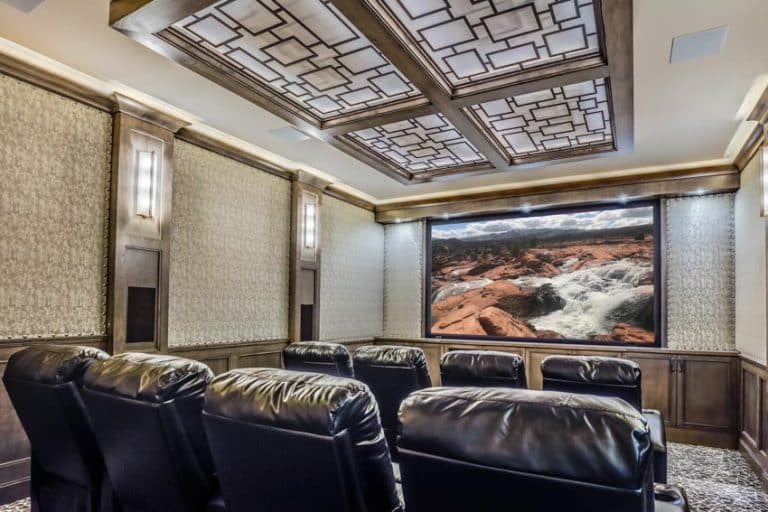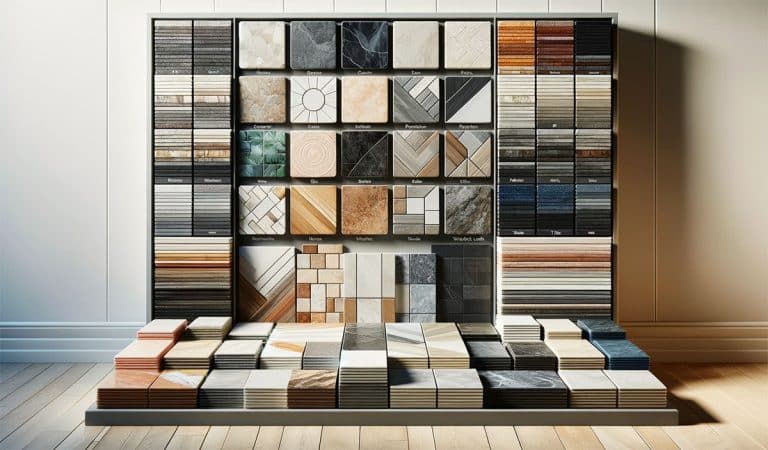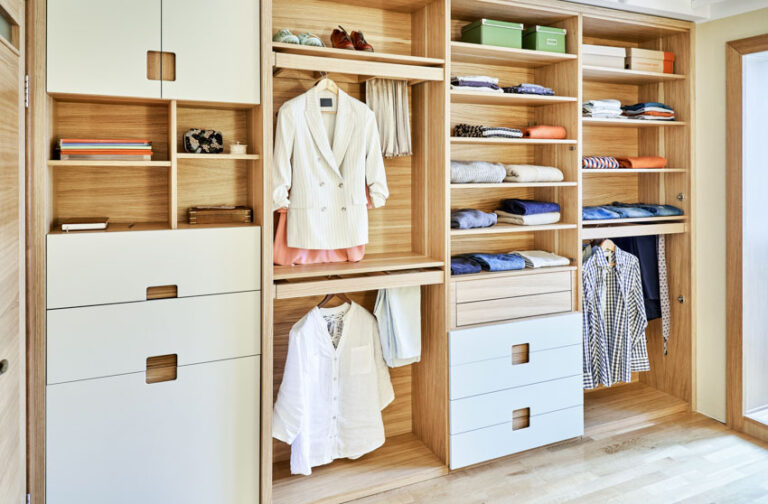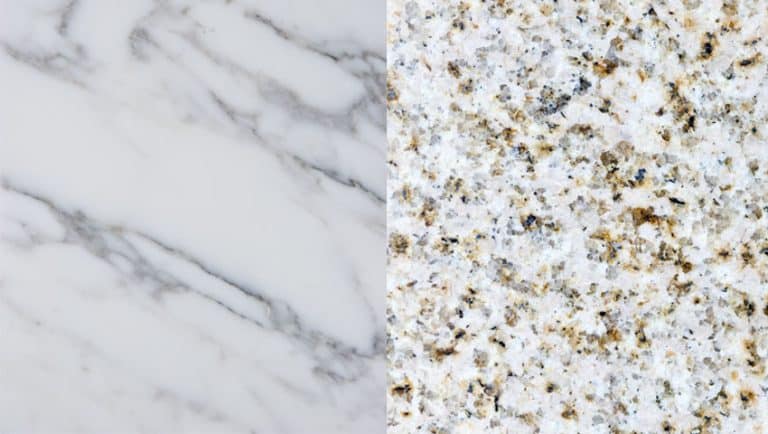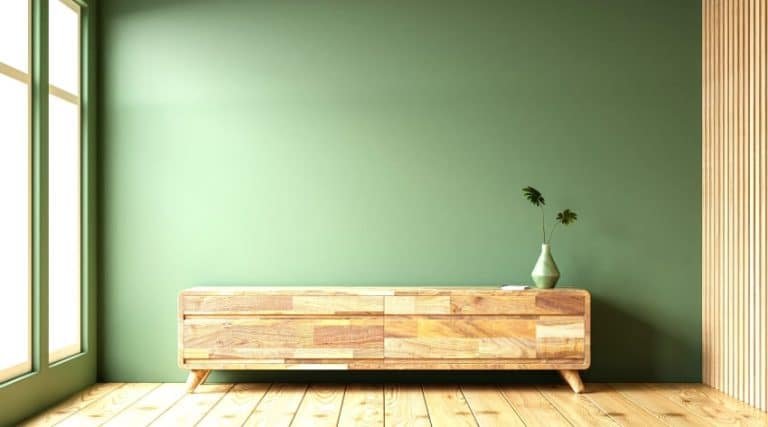23 Most-Popular Types of Interior Doors & What Styles To Use
Interior doors play a large role in our homes, they divide public spaces and private spaces, separate work areas from entertaining areas, and, as you’ve seen, can have a great impact on the design environment.
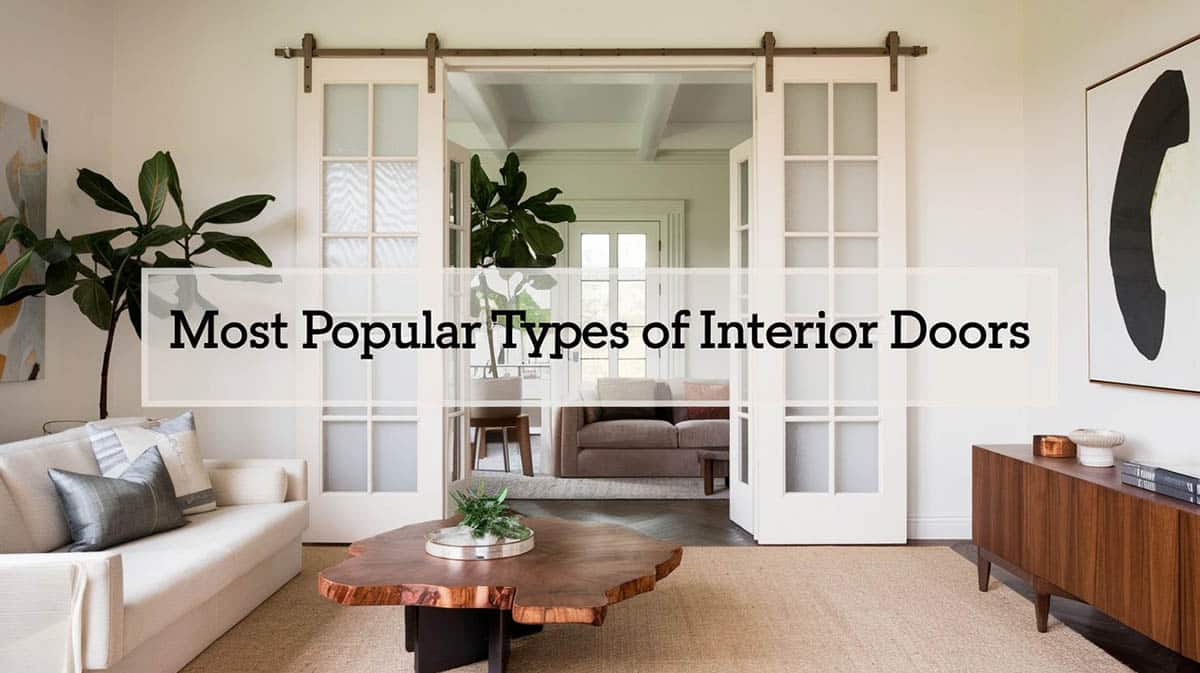
Whether you are building or renovating, consider changing up the entry game, replacing a couple of the basic builder’s doors with fun sliders or space-saving pocket doors. Make a child’s room magical with a hidden door. Design touches every aspect of your home, choose those to reflect your personal style and lend an air of distinction to your home
There are many interior door types to choose from depending on the style of your home and the function needed. When designing your space, they are often an afterthought, after all, they are already in most homes when you move in. A great interior door can tie a look together, stand out, blend in, and even save space.
While taste, style, and aesthetics are important to consider in choosing the right interior door for your home, it is also important to look into other factors, such as cost, function, and the materials used to ensure durability and long lifespan. Below we give you a complete guide on interior door types along with some tips on how to use them for your home.
Quicklook: Different Types Of Door Materials For Interiors
• Wood
• Metal
• MDF
• Glass
• Fiberglass
• UPVC
• Composite
• Stamped Hardboard
Interior Door Materials
Aside from deciding on the type and style of door that you will be using for your home, it is also important to get a general overview of the types of materials that are available for their construction. Each type of material that is used for an interior door has its own positive and negative features. Consequently, the materials you choose for your interior door play a key role in terms of their appearance, aesthetic appeal, quality, performance, and lifespan.
Wood, metal, composites, and fiberglass are the materials most commonly used. Other alternatives include glass, acrylic, and medium-density fiberboard (MDF). For more rustic and traditional applications, you can have them made from reclaimed barn or ship wood. In addition, they can also be solid or hollow core, flush or paneled.
Because interior doors are not exposed to harsh outdoor elements, they are often made of lightweight materials and can be treated in a variety of ways. Read on to learn more about the most popular materials for the interior.
Wood Doors

Natural solid wood has been the traditional material of choice for interior door designs. Often favored for its distinct natural beauty, solid wood provides a warm, organic look and brings natural coziness to a space.
The usage of solid wood interior doors also offers a more pleasant atmosphere to home interiors. They are more inviting and welcoming for guests as they are seen to be more “friendly” compared to a metal door which tends to look “stiff” and cold. In general, solid wood also works well with most interior styles whether traditional or modern.
Solid wood doors in natural colors or stained finishes can cohesively tie the look of a space. Wood, as a material for construction, is also very flexible and can be modified into different shapes and designs, whether rectangular, paneled, round peak shape, arched, French style, or carved. It can be stained or painted in a particular finish or color, allowing more room for design.
Unlike metal, wood interior doors function well in terms of providing insulation. They can maintain heat in a room and hold it effectively. Aside from that, wood products are also known for their impressive durability and strength.
Compared to other materials, wooden interior doors are generally thick and are more stable. They can last for years or even decades, provided that are properly installed, cared for, and maintained.
There are still a few drawbacks to using wood. Wood surfaces can sustain minor damages like scratches, dents, and cracks, but can be repaired easily and inexpensively.
Regardless of the wood type and species, solid wood panels are naturally prone to warping and swelling especially if they are exposed to elements such as changing temperatures, moisture, and humidity. In addition, it is also susceptible to rot, decay, and molds, thus needing sealing and periodic treatment during use.
However, there are specific species of wood that are inherently adaptive to these damaging factors and you can consider them when choosing your material for interior doors. It is also best to avoid using a solid wood panel in a bathroom or other area where it is exposed to a lot of moisture.
Since there are so many available species used for interior doors, the prices for this type of material also greatly vary. But in general, solid wood is the most expensive material for an interior door.
There are a variety of wood species that can be used for a door which range from practical softwoods such as pine, to classic, expensive hardwoods like mahogany or redwood. The most popular wood species are cherry, oak, walnut, maple, and juniper.
Pine is a type of softwood that is commonly used in interior applications such as cabinetry, furniture, and paneling.
Characterized by a pale, yellow color, pine can be used for a variety of interior door designs and styles as it can be treated in a variety of ways. Pine can either be painted or stained to achieve a whole new different appearance.
Pine, as a wood, dents easily because it isn’t a hardwood, so typically, it is subjected to pressure and heat treatment before being constructed into doors to reinforce its strength and quality. Pine finishes are often favored by those with a taste for traditional, rustic, and country-inspired homes.

Oak is another popular species of wood that is used for interior doors. In general, oak has a distinct color that ranges from white to pink, with reddish tones.
Other variations have occasional streaks of yellow, green and black which come from the presence of mineral deposits in the wood. The attractive appearance and variety of colors that oak possesses provide diverse design opportunities as they can be used to match any type of interior style and decor.
Oak interior doors are also durable, hardwearing, and long lasting. They function well as insulation as they help keep heat inside your home. Compared to other solid wood varieties, oak products are extremely affordable despite their high quality.
Cherry wood is well known for its distinct natural deep reddish brown color and fine graining pattern. The best advantage that cherry offers in terms of visual esthetics is that it renders different looks throughout its lifespan as it ages gracefully and changes into different tones of color over time.
Aside from its stunning beauty, cherry interior doors are also highly durable and can withstand scratches and knocks from everyday use. Cherry offers richness and luxury to different interior applications, especially when they are treated with a coat of clear stain.
Although more commonly used in traditional interiors, cherry finishes may also be used for contemporary and transitional homes.
Walnut has a smooth, even, fine-grained pattern and a distinct muted brown color. The appearance of walnut wood is generally more uniform compared to other species as it is filled with straight grains that range from a light reddish gray-brown color to streaks of deep chocolate brown.
Just like cherry interior doors, walnut renders a strong visual appeal especially when they age as they turn into a beautiful mellow color over time. Walnut interior doors are highly suitable for a variety of design styles which range from traditional, transitional, contemporary , and modern.
Maple is characterized by its subtle fine-graining pattern and light color. Maple wood is predominantly white in color but has variations that range from a creamy beige tone to occasional brown undertones. In general, maple has a smooth, uniform color and appearance, allowing it to blend into contemporary interior settings.
When used for interior applications, maple doors are best stained in a clear color to allow their natural light color to stand out. Compared to other wood species, maple is a more expensive material.
Mahogany is one of the most expensive options for solid wood products. It is a kind of straight-grained wood that has a pale pink to reddish brown color. This color often changes into a darker tone which gives mahogany a richer appearance.
Mahogany provides a warm and inviting feel to homes. In addition, they help enhance the natural ambiance of a space and bring in sophistication to its decor. Mahogany doors can also be matched easily with any style and color.
Mahogany is not only prized for its beauty but also for its durability and color. It is one of the most reliable wood species for interior doors as they have a remarkable sturdiness. It is tough and hard to dent, resistant to both decay and insects , and can last for years or even decades.
In addition, mahogany is an easy material to work with, providing a vast opportunity for hand carvings, engravings, and embossing in the door’s design. It is easy to treat, and can be stained or painted in any color.
However, mahogany is more expensive compared to other species of wood. Their price ranges from $500 to $2000 depending on the interior door size and style. But this extra cost is worth it because mahogany outlasts other kinds of solid wood. Just like any solid wood, mahogany surfaces need to be refinished and regularly maintained.
Redwood is one of the most beautiful woods available for use in interior doors. It has a unique rich, red color which creates visually stunning designs. In addition to the high value of aesthetic interest that they add to spaces, redwood is extremely durable.
Redwood interior doors are inherently weather-resistant and termite-proof because they produce natural oils that give them adaptive properties. Perhaps, its greatest attribute though is its ability to retain moisture and stay vibrant longer than other wood species. Compared to other woods, redwood does not shrink and decay easily.
Juniper are coniferous plants that belong to the family of cypress trees. As a material for interior doors, juniper is long-lasting and offers a beautiful, natural, one-of-a-kind look that is characterized by unique knots and splits and large, swirling graining patterns.
The color of juniper wood ranges from lighter tones to deep shades of brown and cinnamon red. Over time, its natural color darkens to a rich tone, giving it a whole new heightened level of appeal. Wood experts even describe the appearance of juniper wood to be “sensual”.
Juniper surfaces are best stained, but they can also be painted to achieve a whole new different look and color. They work well in the interior of traditional homes because of their rustic character.
In addition to their stylish looks and sustainability, interior doors that are made with juniper are high quality and durable. Although a type of softwood, juniper shrinks and swells less compared to other wood species, thus they are more resistant to moisture and other elements.
With proper installation and maintenance, juniper products can last for up to fifty years or more. Cost-wise, a juniper wood door falls somewhere in the middle range and typically starts around $1300 per piece.
Metal Doors

As an alternative to traditional solid wood interior doors, metal and steel are slowly gaining popularity in the interior design scene. Although metal may not be your first option when looking for doors for your residences, it complements specific design styles better and presents a number of advantages.
Metal interior doors offer a more streamlined look compared to standard wood or MDF. They are well suited for contemporary and modern-inspired interiors.
Metal is also known for its extreme durability. Unlike solid wood which is prone to warping, decay, and rot, metal is not susceptible to such damaging factors. Metal interior doors are also fire-resistant and do not easily crack or bow.
They are energy efficient and do not require any routine maintenance. Although prone to scratches and dents, metal surfaces can be easily repaired. In terms of cost, metal doors are generally cheaper than a classic door that is made up of solid wood.
Some popular variations of metal doors are steel and metal with glass inserts. Steel interior doors are not really made of one solid slab of steel. Instead, they are typically constructed with polystyrene or polyurethane cores that are encased in a steel cover.
Metal interior doors with glass inserts, on the other hand, provide more interest and a less heavy appearance. Some manufacturers also offer metal products that have cutouts and designs and allow for customization.
Metal products are also available in different framing designs and a wide variety of color options. Typically, they are factory-primed, which means that they can be painted based on your own color specifications.
MDF Doors
Medium density fiberboard (MDF) is a type of engineered wood product that is mainly composed of recycled wood fibers. It has become one of the most common interior door materials because of its affordability and durability. MDF interior doors can withstand humidity and heat better than solid wood.
Unlike traditional and natural materials, MDF is less likely to warp, and is resistant to decay and rot, making them the ideal choice for rooms that are constantly exposed to humidity and moisture such as bathrooms and kitchens.
MDF surfaces won’t chip or crack due to heat exposure and won’t expand or contract either, making their finishing longer lasting.
In terms of appearance, MDF surfaces typically mimic the appearance of natural wood. Despite lacking wood grain texture, MDF panels are smooth and easy to finish. So in case you decide to change the color of your doors, you can change its appearance and paint it with a new color easily.
And since they can be stained or painted, MDF products offer high versatility and flexibility regardless of the style of your home. A large variety of MDF interior doors are also available in a wide range of attractive styles, which include paneled styles and modern looks.
Glass Doors
Glass doors are a common feature in modern and contemporary homes. In general, glass doors may either be made up purely of glass or may be combined with another material such as wood or metal.
The latter is usually referred to as “glass paneled” and is more decorative in form, as the glass is typically installed in the form of panels to create an accent in the door’s design. Whereas the former is more commonly found in commercial establishments like stores, malls, etc.
Individual glass panes are often referred to as “lights” or “lites”. Popular variations of lights in glass paneled doors include frosted glass, smoked glass, clear glass, textured glass, and colored glass.
For more decorative designs, stained glass may also be used. While for residential entrances and main doors, ornately patterned and etched glass is your best option.
One of the greatest benefits that glass offers is that it allows light to pass through. It allows natural sunlight to enter into a room, significantly enhancing the ambiance and the appeal of the interior.
Not only does natural light look more pleasant than artificial lighting but it also contributes practical benefits such as energy efficiency and reducing the need for artificial lighting which consequently lowers the cost of electricity. And since there are also fewer dark areas and fewer shadows in the room, the area can be used more efficiently.
For some homeowners, the major disadvantage of glass interior doors is that they lack privacy. However, there are still other ways to enjoy the benefit of glass panes while also enjoying privacy. Frosted glass, graphic coat glass, and colored opaque glass are some of the options that address this issue while also adding visual interest to a space.
Another advantage of glass is that it is easy to maintain, requiring only occasional wiping with the use of a soft cloth and glass cleaner.
Compared to metal doors, which have the tendency to rust or corrode, and wood which is prone to molds, decay, rot, and warping, glass is not susceptible to the aforementioned damaging factors. However, they tend to crack or break when subjected to a heavy blow or trauma.
Glass-paneled doors need to be well-built and sturdy. You can look for tempered glass or toughened glass to make sure it does not break easily or shatter. Also, make sure the glass is well sealed against the stiles and rails of your framing material.
Common types of interior doors which are made up of glass are storm, sliding, and folding doors. Among the three, the most popular is glass sliding.
Fiberglass Doors
Fiberglass is widely used in manufacturing furniture, windows, doors, and other forms of interior decor due to its flexibility and ability to be molded into custom shapes. By definition, fiberglass is a type of reinforced material that is composed of glass fibers that are embedded in resins.
Fiberglass doors can be used in both interior and exterior applications. In general, fiberglass offers security, energy efficiency , and aesthetic quality. Fiberglass is much stronger and tougher than wood or steel.
Unlike natural wood, fiberglass does not warp or expand when exposed to moisture. They do not get scratched and their finish does not peel.
In addition, fiberglass interior doors also do not need any special maintenance at all, except for occasional wiping and general cleaning to keep them in good condition. However, they can be a bit challenging to repair once damaged.
As mentioned, fiberglass is one of the most versatile and flexible materials in the market, which means it can be customized to produce different styles, designs, sizes, colors, and finishes.
Fiberglass doors are typically molded to resemble natural hardwoods such as mahogany and oak. They capture the wood grain patterns of these woods and can be made into a variety of colors.
Fiberglass surfaces can be painted in order to match your desired color scheme and style. In addition, fiberglass interior doors can also be decorated with decorative glass panels or they can be mixed with other materials like steel or wood.
Fiberglass doors can make a good impression when used for a home. It offers the same beauty that wood has, but minus the drawbacks that typically come with it. Whether you are aiming to achieve a rustic style or a modern look, fiberglass can help complete the desired overall look for your home.
UPVC Doors
UPVC or plasticized polyvinyl chloride, also known as rigid PVC or vinyl siding, are basically PVCs that have no plasticizers added to them. UPVC interior doors are less flexible than PVC, they can last for years without any damage and are fire-resistant.
In direct contrast to traditional solid wood, UPVC surfaces do not need any form of finishing such as varnishing, painting, staining or sealing. However, UPVC is thinner than solid wood and has less strength.
Composite Doors
Composite interior doors are another type of modern alternative to traditional materials. Composite products are made up of multiple layers of materials which are comprised of a core that is made up of wood, insulation , and a number of other materials which are protected by a weather-resistant outer skin.
Compared to UPVC, composite is more expensive but their benefit outweighs the additional cost.
In terms of design application, composite products come in different colors and finishes which may sometimes mimic the appearance of wood. Typically, these interior doors are finished with veneers such as red oak, alpine oak, birch, lauan, and mahogany.
Stamped Hardboard
Stamped hardboard is often the most affordable material for interior doors. Stamped hardboard is made up of engineered wood known as “hardboard” or high-density fiberboards / HDF. This is commonly known by the brand name Masonite.
Hardboard is generally a soft material as it is made up of steam-cooked, pressure-molded molded , and compressed wood fibers, but it is usually covered with a hard-baked paint. Hardboard is similar to particle boards and MDF but it is stronger, harder, and denser.
Typically, stamped hardboard doors are constructed as “hollow core” but in some cases, they are filled with foam or reinforced with particle boards. Stamped hardboard is a more affordable alternative to other materials, but they can be easily dented.
They are also not advisable to be used in wet areas like bathrooms since these have the tendency to sell when exposed to moisture for prolonged periods. When damaged, stamped hardboard surfacescan be difficult to repair. However, if treated with proper care, they can look great for years.
In terms of appearance, stamped hardboard doors are typically molded to mimic the look of natural wood grain. It can be painted in different colors to match any style of home, and it also comes in a wide range of designs which include paneled, glass inserts, louvered , and French style.
Masonite also produces stamped hardboard interior doors in a wide variety of designs and you can view these in their website.
Overview of the Types of Door Material Pros and Cons
| Door Material | Pros | Cons |
|---|---|---|
| Wood | Natural beauty, warm & organic look, versatile design, good insulation, durable | Prone to warping, swelling, rot, decay, molds, susceptible to scratches, dents, cracks |
| Metal | Streamlined look, extreme durability, fire-resistant, energy-efficient, low maintenance, affordable | Prone to scratches and dents, may look “stiff” and cold |
| MDF | Affordable, durable, withstands humidity and heat, less likely to warp, resistant to decay & rot, versatile, flexible design | Lacks wood grain texture |
| Glass | Modern & contemporary, allows light to pass through, is energy-efficient, and easy to maintain | Lacks privacy, prone to cracking or breaking when subjected to heavy blows |
| Fiberglass | Strong, tough, resistant to warping & moisture, low maintenance, versatile & flexible design, customizable | Challenging to repair once damaged |
| UPVC | Long-lasting, fire-resistant, low maintenance | Thinner & less strong than solid wood |
| Composite | Multi-layered construction, versatile design, weather-resistant | More expensive than UPVC |
| Stamped Hardboard | Affordable, can mimic natural wood grain, versatile design | Easily dented, not suitable for wet areas, difficult to repair when damaged |
Door Categories
In addition to the common materials used for construction, the types of interior doors also vary in terms of the type of construction. Interior doors may also be classified into three general categories namely: solid wood, hollow core, and solid core.
Solid Wood Doors
By definition, a solid wood door is made up of individual natural wood elements that are fitted together to form a single unit.
Solid wood doors are typically made of 100% natural wood like mahogany, oak, maple, cherry, pine and walnut. Due to their durability solid types are often used for front door designs.
In terms of appearance, solid wood possesses the most appeal because of its inherent warmth and coziness. They are typically stained or painted and come in a variety of designs that can match any style of interior.
Solid wood doors are extremely sturdy and naturally have the most “weight” to their feel. They look more substantial and operate with greater effort because of the heftiness of the materials used in their construction.
Solid wood surfaces also offer resistance to chipping and cracking because they are thicker compared to other interior door types. They provide a good source of insulation and also provide a natural sound barrier compared to a hollow core.
In addition, solid wood products also last for years. However, since a solid wood door is made entirely of real wood, they are prone to damaging factors such as molds, rot, decay, and excessive moisture.
While generally the most expensive option, most homeowners still consider it to be a worthy investment because of their durability and lifespan. A solid wood door can also significantly increase the value of one’s home, while also maintaining a classic feel and historical vibe all throughout the space.
Solid Core Doors
Solid core doors are typically made up of composite wood such as plywood or a molded composite exterior with a wood fiber-filled interior that mimics the sturdiness of real wood. A popular material used for solid core products is “Masonite”. Usually, solid core surfaces are painted or faced with veneers like birch, oak, fir, beech, alder, etc.
Since solid core doors are made up of dense composite materials, they can sometimes be heavier than natural solid wood and hollow core. The fillers and resin used in their composition also add up to their weight.
Due to this density, solid core doors provide better insulation, and temperature control and offer excellent sound and noise blockage between rooms. Solid core also has better performance compared to the hollow core.
However, there are still a few cons to using a solid core design. Their weight is mainly a major issue as solid core doors always need to be installed by two people. They are not recommended for self-installation. And since they are heavy, they have a great tendency to contract when exposed to high levels of heat and humidity.
In terms of appearance, solid-core doors generally closely resemble the look and feel of a solid wood door. They can render the same “expensive feel” that natural wood has. Although nothing can truly be at par with real wood, solid core products offer a perfect, cost-effective alternative.
Hollow Core Doors
Hollow core doors are generally the least expensive and most budget friendly option of the three materials for interiors. They are constructed from rigid, honeycomb cardboard that is encased by a wood frame such as plywood or hardwood to maintain their shape.
In other cases, hollow core doors are also wrapped by a fiberboard shell. The cardboard honeycomb core sheathed in softwood frame is typically faced with thin wood veneers.
Essentially, they are “low-cost” versions of flush doors and make good alternatives especially if you need to furnish your home with a large quantity.
Hollow core doors are more lightweight than solid wood and solid core. And since they are generally lighter, they also provide the least amount of sound blockage. They are not as durable and fire resistant, but provide the best resistance to warping. Making them ideal for use in homes that have changing heat and humidity.
Since they are hollow, they are not as durable and won’t block noise as well as solid wood and solid core. They are more prone to damage, dents and punctures and allow a considerable amount of sound transfer. In terms of lifespan, hollow core products can last for decades, provided that they are properly maintained.
Popular variants of hollow core doors are faced with lauan mahogany veneer, oak, and birch veneers. Those finished with lauan mahogany veneers are the least expensive but soak up paint quickly like a sponge
Door Configurations

Interior door configurations can either pertain to the way a door opens or its direction of opening. In some cases, it may also pertain to side lite entry configurations or the way panels and “lite” are arranged in a door panel.
There are numerous options for interior door configurations and most suppliers offer their own signature versions. The most common interior configurations based on side lite entry for single doors are four-panel half-moon, six-panel, two-panel half-lite, two-panel three, quarter-lite, and full-lite.
While for those that typically have more than two panels, the most common configurations are double one side fixed, two side lites or panels, single side panel left-hand swing, single side panel right-hand swing, left side lite and right side lite.
Door Styles
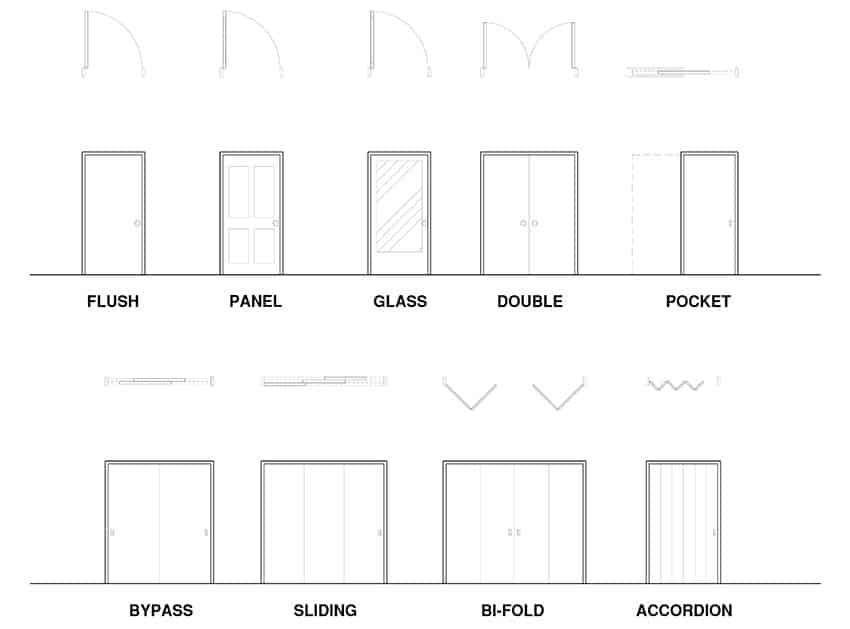
Pocket Doors
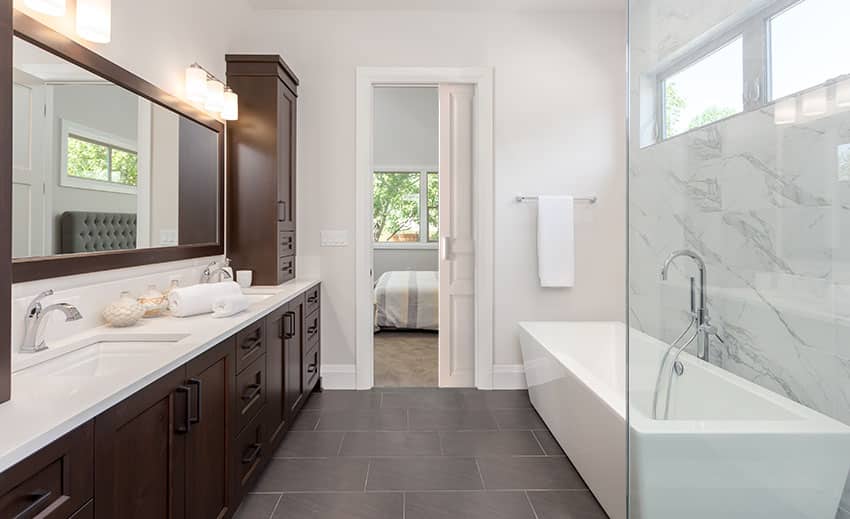
Pocket doors are having a moment right now in the world of design. Pocket doors operate the same way a sliding door works, but essentially it is a single piece or panel that is mounted to a rolling overhead track and slides into a space or “pocket” installed in the wall.
The frame consists of a side jamb that is split in order to receive the door and a top jamb that has a built-in track.
The top of the door itself is mounted with rollers to allow it to glide along the track. Nowadays, there are several variations of the pocket door which allow double doors to be stowed away on either side of a wall or doorway.
An “old school” favorite, these types bring in a nostalgic feel to homes, while also maximizing every inch of space.
The pocket recess allows you to create more wall and floor space because they don’t need clearance to swing out. They simply slide into the space between two walls, making them suited for residential units with limited spaces like apartments, flats, and condominiums.
Pocket doors are also ideal for use in small rooms like bathrooms, powder rooms, closets, or music rooms. (Visit our article page about types of closet doors to see more styles)
Another added benefit of the pocket style is that they also fully conceal the door into a wall, which provides a fully unobstructed doorway. With the amount of clearance that it provides, they are good solutions for meeting universal design standards.
They also make a highly suitable option for rooms that rarely need to be closed. While in terms of appearance, pocket doors provide a more “open” feel and a more clean design.
Pocket sliders are available in single and double styles and an almost endless variety of materials like wood, metal, and composite.
The glass and wood products reminiscent of French doors are a fantastic choice for dividing a living room and study, they still let light flood into the space and keep a connection between spaces while still providing privacy and separation.
In general, pocket doors may be used in a variety of interior styles which range from traditional, transitional, contemporary , and modern.
Flush Doors
Flush doors are the simplest type in the market. They are characterized by a completely flat surface on both sides – a plain design with no panels and ornamentation. The most common types of are regular hinged, but often they are also flush. Compared to other interior types, flush styles offer an affordable option for most homeowners.
Flush doors are typically sold in a solid format that is completely made up of solid wood, but it is also available in hollow core format, usually lightweight and comprised of two layers of thin wood encasing a honeycomb cardboard core.
Flush doors are quite versatile because you can choose a variety of finishes for them. They are commonly stained with wood stains and painted, but their flat, smooth surface also allows for more special finishing treatments like wallpaper. They can be bought “pre-finished” or ready to paint.
In addition, they are also highly customizable as they can be reduced or increased in size easily. They can be easily matched and furnished with any type of door hardware and can be used for a variety of applications. Basically, they provide flexibility in terms of design and decor since they can blend well with any interior style for a home.
Flush interior doors offer a classic option and a clean look for your home. What makes this so interesting is that you can create a “hidden door” with a flush door. Imagine a child’s room with a cool mural, the mural also covering the door, blending right in with the wall , and creating a sense of fantasy and magic.
Flush styles are popular in Japanese design as well, where their simple, clean lines quietly blend into the background. This type of door tends to be the most common type found in contemporary and modern home settings because their simplicity and clean looks complement minimalist interiors well.
They often come as a complete prehung unit that is flat and smooth on both sides. These types include the door, frame, hinges, and hardware all in one unit to make installation easier.
Panel Doors
Panel doors, as their name suggests, are divided into panels. They are also often referred to as “stile and rail doors: because they are built with a prehung frame and panel construction.
The framework of panel designs is made up of vertical stiles and horizontal rails that frame flat or raised wood panels or glass panes.
This construction method is popularly used for solid wood doors because it helps minimize the effects and tendency of the wood to warp, swell, and shrink with changes in temperature and humidity.
Typically, panels are made up of different varieties of timber timber sheets which are set on timber frame structure. Alternatively, panels can be made up of fixing pressed hardboard sheets onto the frame of the door itself.
Panel doors are the most commonly used interior type for residential spaces. We most often see 4 or 6 panel styles in homes in the United States, but they can be custom-made to your specifications if you are looking for a super-paneled look. Panel designs can either have square or rectangular patterns that can range from a single large panel to eight or more small panels.
There are also several variations of the panel door which include rounded and arched tops, or in some cases more decorative designs that feature glass inserts.
Currently, the most trending panel interior door designs for homes are standard whole-panel, three-panel mission, and five-panel equal doors. However, you can choose to customize the number of panels and the type of design that goes into your panel detail.
Paneled styles render a traditional look to any space. They are typically sold unfinished but can be painted or stained in any color desired.
Panels may include glass inserts instead of wood, for homeowners who prefer a more open look. Basically, there is a wide range of design options when it comes to style, color, and materials and ultimately, selecting a door from this category will all depend on one’s personal taste and preference in style.
To examine whether you are getting the best quality, examine whether the door is built with accurately fitted and interlocking sections.
In terms of cost, panel doors are more expensive than flush design. In order to save on costs, you can opt for medium-density fiberboard (MDF) door instead of a solid wood panel since they offer the same looks but require lower maintenance.
Glass Doors
For homeowners who want to maintain an open look for the home, glass doors are the perfect option that can be explored. Glass doors provide an easy way to update and give your home a modern and contemporary feel. As mentioned earlier, they may either be made entirely out of glass or may be combined with another material, such as a wooden or metal frame.
Glass doors are typically made of glass panels which are typically ½ inches to ¾ inches thick. These glass panels are usually tempered or toughened in order to reinforce their strength and prevent them from breaking easily. Also, glass designs may either be swing-type or sliding.
Swing glass are usually hinged and may either be frameless for a more streamlined and modern look. Sliding glass, on the other hand, usually has wooden or metal frames. However frameless glass designs are more commonly used in commercial establishments rather than residential applications. In terms of interior use, frameless glass doors are also widely featured in bathrooms and shower enclosures.
Another popular form of glass doors is glass paneled. Glass paneled, as their name suggests, are panels of glass that are separated by vertical stiles and horizontal rails to produce a “pane” look.
Glass paneled doors come in different configurations which range from single glass panels to up to more than ten panels which is a favorite for French glass doors.
Glass is also ideal for those who find solid wood too bland or “heavy looking” as it provides diversity in terms of finish, texture, and material. Glass allows plenty of light to enter around the home. Consequently, the abundance of natural light results in energy efficiency and savings in terms of electricity costs because it lessens the need for an artificial lighting source.
Compared to other interior door types, glass products are more decorative. The market offers a wide array of glass designs, colors, and textures that may be used to produce interesting designs. Glass panes may either be clear, frosted, graphic coated or back painted, texture, etched, embossed or sandblasted, providing more opportunity for matching in your home’s interior decor.
Glass products are also highly customizable. All manufacturers offer tailor-made glass doors based on your required measurements. When purchasing, the key guideline to keep in mind is that they should be constructed from at least 8 millimeters of toughened glass to ensure their durability and lifespan.
Double Doors
A double door is entirely different from a double acting door. By definition, double doors are pairs of two vertical panels that meet in the middle of the frame when closed.
Whereas, double acting doors, also known as double swinging, or impact traffic, are a single panel or a pair that can swing in both directions because of a special type of hardware known as pivot hinges or double acting hinges.
Typically, for paired double acting doors, the door to the right is considered the active one, while the one on the left is fixed (when viewed from the outside). In summary, double designs pertain to a pair of doors, while double acting pertains to the type of operation.
Double doors create a striking entrance and give an increased aesthetic value to the home. With twice the opening, your home looks more grand and spacious, which is why they are more commonly used for the main entryway. However, this type is more advisable for large homes as they take up a large amount of room.
Double panels come in different styles and designs and allow for full customization in terms of sizes, color, finish, and materials, providing more options that will match one’s personal preference in style and budget. The most common materials are solid wood, glass, metals, composites or sometimes, it may even employ a mix of these materials.
One of the most famous designs for the double door are French doors which we cover in more detail below.
Sliding Doors
Traditionally, sliding doors are a common feature in Asian houses, particularly those that have Japanese inspiration and style. From delicate shoji screens to minimalist glass and rustic barn doors, sliders have become an increasingly popular option because of the clean look that they lend to spaces.
By definition, sliding doors is a type that opens horizontally by a sliding motion. They usually glide on a track which are mounted on either the top or bottom.
Sliding doors that have trolley hangers on top and run on a concealed track are called “top hung sliding”, while those that have two rollers at the bottom and two guides at the top are called “bottom rolling”. The latter is commonly used for those whose weight cannot be supported from above.
Popular examples of sliding doors are barn and French, while the most common materials for this type are wood, metal, and glass. The main advantage that a sliding mechanism offers is that they are an incredible space-saving solution.
Since they do not swing, sliders are useful in areas without available floor space. However, they require adequate space to either the right or left side to ensure that they can slide freely back and forth.
For areas that do not have enough room for swinging doors, sliders are your best bet. This makes them an ideal addition to residences with limited spaces such as apartments, condominium units, and flats.
They also help in keeping a room more “open”, especially if made with glass, allowing more natural light and ventilation to enter into space. Sliding designs attach to a rail that is mounted on the wall and is perfect for larger door openings. They can be used for openings to patios, lanais, and balconies or in transitions from one room to another. See examples of living rooms with barn doors here.
Sliding doors are a great way to make a statement in a space. They have a huge impact on the look and atmosphere in a room.
Depending on their design, sliders work well in the interior for both traditional, transitional, modern, and contemporary settings. The only disadvantage that sliders have is that they have very little sound insulation as compared to other interior types because their seal is less robust compared to traditional swing designs.
In terms of design, sliding doors provide a vast range of options that allow you to create the right design for your home.
You can use reclaimed barn doors, teak from old ships, or framed panes of stained glass, as long as you’re rail system is professionally installed and strong, you can choose materials that traditional hinges can’t carry.
A reclaimed wood slider on the rough brick wall of an old factory-turned funky loft gives a lot of warmth and texture. Create the feel of a luxury spa by using a glass sliding panel between a master bedroom and an Ensuite bath.
Accordion Doors
Accordion doors are also another type of space saving design. Rather than operating on a swinging motion through the use of hinges, an accordion door is characterized by opening and folding back in sections, thus forming a shape that is similar to an accordion.
Unlike pocket doors which disappear into a wall, accordion styles typically fold up to one side. Usually, accordion doors are used as partitions and dividers between spaces aside from being entryways.
The main advantage of an accordion door is that it gives homeowners the option to install a self-contained unit that does not take up much of the floor space on either side of the door.
Unlike traditional designs which require clearance to open and close, accordion doors only require a minimum amount of space for threshold. This make it an ideal option for residential spaces with small areas as they help maintain a maximum amount of usable space.
Accordion designs are also easy to operate. In some cases, regular swinging doors are prone to slamming and opening or closing loudly. The noise which comes from such may sometimes be disruptive especially if you want to create a peaceful environment for your home.
Accordion doors also offer versatility as they can be used in various applications and can be modified into different sizes. An accordion product can be trimmed at the bottom to fit any size opening. In addition, it is also available in a wide range of materials such as wood, wood, glass, vinyl or plastic.
Bypass Doors
Bypass door are somewhat similar to sliders. These lightweight interior designs operate on a sliding motion and hang from rollers that run along an overhead track.
The components of a bypass door include a metal frame that runs along the bottom and the two vertical sides of the unit. They are typically mounted in pairs or threes, and can either slide along one axis on parallel overhead tracks or slide past each other in the process.
Essentially, these door sections slightly overlap or bypass one another to allow access. When viewed from the front, bypass designs do not have any visible gap between them.
Bypass doors are more commonly found on closets, storage areas, and shower enclosures. For closets, the most popular type is the mirrored version since they allow access to one side of the closet at a time, while also providing a full head-to-toe mirror for viewing oneself while getting ready.
There are several advantages to using bypass designs, the first is that they do not take up much floor space. Second is that they are relatively easy to install compared to swinging designs. However, one of its major drawbacks is that the sliders or rollers may become hampered over time.
Maintenance can also be a bit of a challenge since the door units overlap, making it hard to reach certain areas, while the bottom tracks also tend to collect dirt and grime over time.
Bypass doors are available in stock at home improvement stores at an affordable price. They are sold in different materials which include glass, wood and MDF. The design of bypass doors, on the other hand, includes louvered, paneled, mirrored, and screened doors.
Bifold Doors
Traditionally known as “concertina”, bifold doors are a set of interior panels that are attached together by hinges, and slides open while their panels fold into each other and stacked neatly against a wall.
Bifold doors are mounted and hung from a track and can have anywhere from two to seven panels. It is also sometimes referred to as a “folding door”.
In terms of operation, bifold panels combine both the mechanisms of sliders and hinges as they use end pivots on pins that are inserted at the top and bottom edges, thus resulting in a greater opening space compared to a regular sliding door.
Bifold designs are available in a wide range of materials which include wood, metal, glass or composites such as wood covered with vinyl.
Bifold doors are best considered for use in small spaces as they do not require a full swinging door footprint. Bifold products are most commonly used as enclosure in areas like laundry rooms, bedroom closets, and the kitchen pantry.
They are also typically round in rooms which connect to outdoor areas such as entrances to a garden, balcony, lanai or conservatory. They work great in keeping a place feel “open” and for allowing maximum amount of natural ventilation and sunlight to enter into a space, while also creating an illusion of extra space.
In terms of appearance, bifold doors are slim and provide a minimalist aesthetic. In addition, they also provide impressive security and functionality. Because of their clean, streamlined looks, bifold panels can be used for contemporary and modern settings, depending on their design.
French Doors
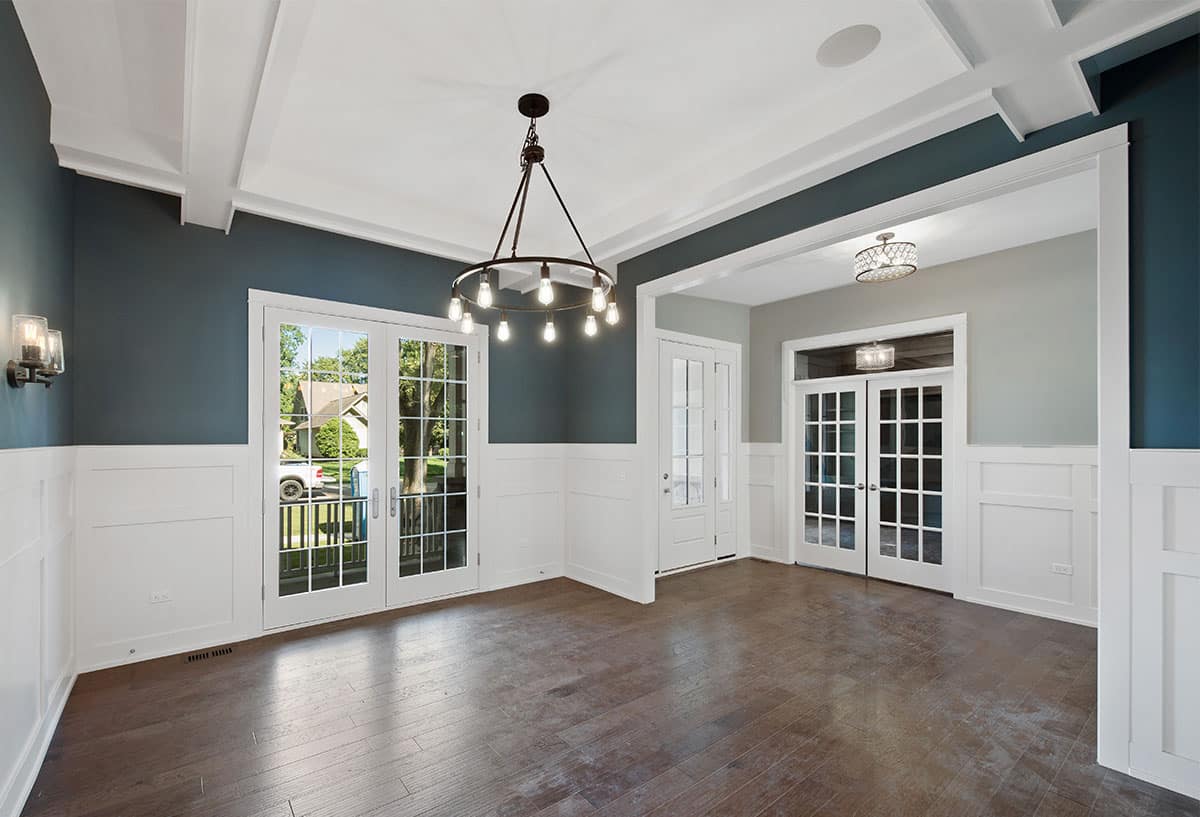
French doors are characterized by their classic appearance which is made up of a door panel with glass panes that extend throughout its length. French doors have a configuration that contains two glass paneled doors that are hinged to the side of the side of openings and swing toward one another. French doors commonly use glass inserts or decorative panels with a wooden frame.
French doors are often thought of for the exterior but they make quite the impact inside, too. Interior French doors aren’t as strong as their element-exposed cousins and come in single and double styles. They can be used as an entry to patios or to separate two different spaces.
French doors bring in privacy while also allowing visual connection between two spaces. They add a dramatic touch to entryways while also offering a touch of glamorous decor to a home.
Aside from being functional, they are geared toward providing more aesthetic appeal and visual interest. They work best in areas of the home that are meant to be displayed like patios, living rooms, music rooms, master bedrooms, home offices, etc.
If you wish to separate your dining and living spaces and give an air of luxury and openness, opt for French Doors. Although typically a mainstay in traditional home settings, they may also be used in more contemporary designs.
Have a large master bedroom? Give it the French door treatment, for added privacy, use textured glass. It will still allow natural light to flood through the door but no one will be able to see that you haven’t yet made your bed!
French doors are a natural choice for a living room that opens out into a climate-controlled Florida room.
Hidden Doors
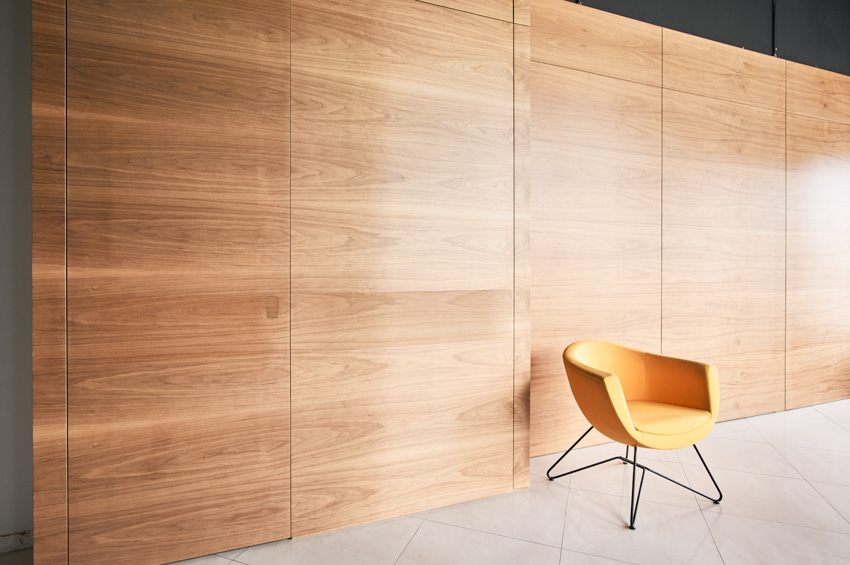
Hidden doors, as their name suggests, are meant to be concealed and are designed to be unnoticeable in a home. These types are often custom-made and can be integrated into the design of built-in furniture.
Hidden doors are a practical way to increase storage and add a little bit of secret fun to a space. They help save up floor space since you can create multi-functioning built-in furniture to conceal the doorway.
These types also offer the perfect opportunity to put a neglected space into good use. In addition, they may also be used to keep an entire room out of sight, like a safe room.
Hidden doors look like bookshelves or cabinetry and can be painted or stained to match the other woodwork in the room. They are a good solution for closet doors in a small room, they add shelf space in an area where you might not have the wall space for standard bookshelves and they make getting into the closet seem like a magical adventure.
You often see hidden doors in offices and home libraries, where you can surround yourself with walls of books, sink into a warm, worn leather reading chair, and get lost in the grand homes of Rivendell. Several blogs have hacks for creating DIY hidden doors with inexpensive Swedish bookcases.
Dutch Doors
Also known as “stable” or “half”, Dutch doors are divided horizontally in half. Dutch doors are split between the top and the bottom, so you can open one part but leave the other part open. Most people think of exterior styles when they see Dutch doors, but they are a great addition to the interior of your home.
You don’t have to split them in the middle, they can be cut to be split 2/3 of the way or ¾ of the way up or down the door. The bottom half and top half can be different materials, such as wood on the bottom and glass panels on top.
Traditionally, Dutch doors were used to keep animals out of farmhouses or to keep children within the confines of a home. However, throughout the years, the design of Dutch doors became more versatile.
Dutch doors are available in a variety of colors and designs which often include decorative moldings, glass panels, and unique paint and stain finishes. Although considered to be more traditional because of their classic looks, they have become widely updated and suited for more modern home settings.
Dutch doors offer a perfect way to connect spaces, especially for rooms in the house that have space restrictions. Its special design works well for dividing spaces and opening rooms to the outside environment while allowing light and air to pass through.
Dutch doors may be used as a primary entrance or they can be utilized as doorways for kitchens, tool sheds, workshops, back exits, offices, or nurseries.
A playroom is a great place for a Dutch door. The bottom half can remain closed, containing and hiding the mess, and the top half can remain open so you can hear the kids and easily see into the room as you pass by.
It gives them a sense of independence because they are playing with the door closed but you can still pop by from time to time to make sure they haven’t decided to use the innards of the bean bag chairs as snow.
Interior doors play a large role in our homes, they divide public spaces and private spaces, separate work areas from entertaining areas, and, as you’ve seen, can have a great impact on the design environment.
Whether you are building or renovating, consider changing up the inside looks, and replacing a couple of the basic builder’s doors with fun sliders or space-saving designs.
Make a child’s room magical with a hidden door. Design touches every aspect of your home, choose the types of interior doors that reflect your personal style and lend an air of distinction to your home.
For more related ideas visit our front door colors gallery here.

